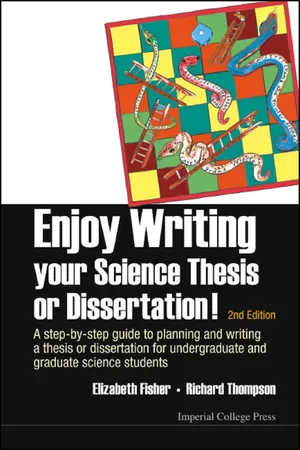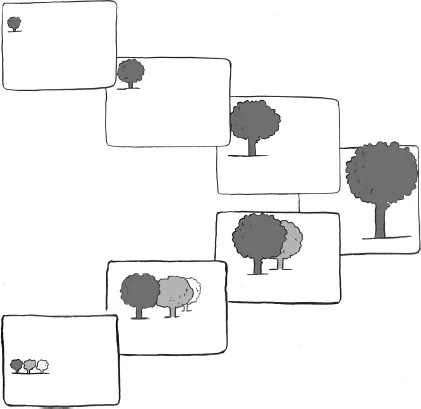![]()
Chapter 1
Overview
You probably have more than enough reading to do and possibly very little time, so this chapter is a short guide to how to write a science thesis or dissertation, with information summarised under useful headings.
Chapter 1 is meant to be read as a whole and will give you a basic understanding of the standard conventions of dissertation and thesis writing, along with suggestions as to the best way of approaching the task. It will help you streamline the process of producing an effective and readable dissertation, thesis, or yearly report for a BSc, BA, BEng, MSci, MPhys, MChem, MSc, MPhil, MEng, PhD, DPhil – or any other degree.
The rest of the book provides more detailed advice about the different aspects of thesis and dissertation writing. Read the parts that are useful to you, take what is helpful and leave what is not.
1.1 Preliminaries
What are the rules?
There are very few rules for writing a dissertation or thesis. The rules that do exist mainly concern the formatting of your work (number of copies, layout, Title Page, Abstract or Summary, binding and so on) and these differ between departments and universities. Find out your local rules immediately – look online and ask your supervisor. Also check whether there is a deadline for the submission of your thesis.
While there are few rules, there are many conventions – modes of writing that we all conform to, usually because they are efficient ways of conveying information. Each discipline has its own conventions for the structure of theses and dissertations. The best way of finding out about the conventions in your area of research, and your department, is to ask your supervisor to recommend a good recent dissertation or thesis in your own field as a guide to form, length, content and style.
Interim reports
You may well have to submit interim reports for your project, for example, quarterly or first-year reports. Approach them in the same way as your dissertation or thesis, although they will be mainly concerned with Materials and Methods, and Results sections. Try to produce a professional and well-written document. These reports might well be usable as parts of your final dissertation or thesis, which will save you a lot of work at the end of your project.
Where to write
Writing your dissertation or thesis will be hard enough at the best of times. Find somewhere to write where you can concentrate on your work and will not be interrupted too often. You will be spending a lot of time in this place so make it comfortable. Your concentration will not be helped if you develop chronic backache, so check your chair is the right size and the table or desk the right height for you. Make sure you have easy access to cups of tea or coffee, biscuits, etc. – the essentials that will keep you going (see Figure 1.1).
1.2 Creating a Plan for Your Thesis or Dissertation
The importance of planning
A dissertation or thesis is not simply a list of experiments or calculations accompanied by a vague outline of what they all mean. The text needs a clear structure that starts by introducing the reader to the topic, then states the aim of the research, shows the results and finally discusses their significance. You need a plan. Without one, it’s easy to overlook important points or jump about randomly from idea to idea.
Figure 1.1 The essentials of thesis writing.
This guide is written on the assumption that you will first develop a complete plan of your thesis or dissertation. Only when this is in place and you have defined you aim and can see the overall structure of your text, should you start writing. We can’t over emphasise just how important it is to have a plan before you start writing. So we’ll put it in capitals and bold: CREATE A COMPLETE PLAN OF YOUR THESIS OR DISSERTATION BEFORE YOU DO ANY WRITING.
Structure
In your thesis you are taking your reader on a journey (see Figure 1.2). Starting from an overview of your field, you then need to focus in on the topic that you have worked on, explaining as you go why it is important. After you have described your research methods and your results, you then need to zoom out again, explaining the significance of your work in the broader field and the implications it will have for future studies.
Figure 1.2 Plan your thesis or dissertation. Take the reader on a journey from viewing your field as a whole, to looking at your individual contribution, to placing you work back in the context of your field.
As with any other story, the structure of a scientific thesis or dissertation has three parts: the beginning, the middle and the end. In its final form, your dissertation or thesis will probably be laid out something like this:
The beginning:
Title Page
Abstract
Dedication
Acknowledgements
Table of Contents (including Appendices)
List of Figures
List of Tables
List of Abbreviations (also known as ‘Nomenclature’ in some disciplines)
Introduction (including a Literature Review)
The middle:
Materials and Methods/Experimental Techniques
Results
The end:
Discussion and Conclusion
References (also known as ‘Bibliography’ in some disciplines)
Glossary
Appendices
Published Papers
You probably will not have all these sections in your thesis or dissertation, but this scheme provides a basic structure from which to plan your writing.
When planning your thesis or dissertation, take care to refer to each item in order. Do not (as we sometimes see) refer to an item, such as a finding or a method, in one part of your thesis, but describe and explain in detail what this item is later in the thesis.
A useful first exercise is to have a careful look through a few recent theses in your field. Browse through them to see how the work has been divided into sections. Look at the layout, formatting, and font. Decide what you like and what you do not like.
Get your information into a workable form
To start making your plan, you need your information (ideas, calculations, data, etc.) in a form that is easy to arrange and rearrange. Decide on the key points for each section of your thesis or dissertation. You could note the points on paper, on your computer or write them on index cards. Once you have your key points, shuffle them about until you are happy with the order. At this stage it’s also a good idea to plan roughly the length of each section of the thesis. This helps you to get a good balance between the lengths of the different parts of the document. You can always make changes later. As a very rough: your introductory section; your methods section; your results section; and your discussion/conclusion section should all be roughly of an equal length. This rule is not set in stone but gives a good starting point for getting the right balance between the different sections.
One sensible approach is to make notes for your project in the following order:
- Literature Review. This chapter tells the reader the background to your topic and reviews previous work in the area. It will be based on the collection of original sources of information that you gathered during your project. For some disciplines this information is incorporated into the Introduction.
- Materials and Methods (or some other equivalent title). This chapter of your thesis covers what equipment, techniques and procedures you used and how you used them.
- Results. This states what experiments you carried out and what you learnt from these experiments. Some or all of your results may come from computer simulations or theoretical analysis.
- Discussion and Conclusion. This should relate the significance of your findings to your field of study, and give your conclusions and suggestions for future research.
- Introduction. This introduces the reader to your field of research, your aims, and the experimental system or theoretical framework in which you have been working.
- Abstract. This is a condensed version of your whole dissertation or thesis.
Planning your project in this order helps you to see what you did (Materials and Methods), what you have achieved (Results) and what you have learnt (Discussion and Conclusion) – which is often different from what you set out to do and achieve. It then helps you to re-evaluate your original aim (Introduction), and to modify that aim if you have not achieved it, so you can place your results and conclusions in the best context.
The plan given above relates most directly to an experimental project, but it’s also applicable to other types of work, including theoretical projects, computer-based projects such as simulations and observational studies such as in astronomy. In all cases it is possible to identify the techniques you used and the results you achieved, whatever form those results take. Throughout this book, when we say ‘experiments’, we generally include work such as numerical experiments, computer simulations, observations or theoretical derivations.
Although we have referred to each of these components of the thesis as a chapter, you may well want to split it into two or more chapters if there is a logical division of the material.
If you begin writing your thesis on your computer as soon as you start your project, you will have less work to do at the end. Begin with your Literature Review or Materials and Methods/Experimental Techniques.
How to start writing
When you have your detailed plan, put all your notes together in the correct order and check they make sense. Include a rough estimate of the length of the different sections, keeping a balance between the components of your thesis. Show the complete thesis plan to your supervisor and make whatever changes they suggest. You can then begin writing.
Before you start writing have your plan in front of you. Use it when you write – that is what it’s there for. Get hold of the correct thesis template (if available) so you type in the correct format from the start (see Chapter 12: Layout). Some people like to start by getting something, anything, down on paper. They then use these rough jottings as a basis from which to write their text. Others prefer to spend much longer on the initial writing, getting it as near perfect as they can. Choose whichever approach suits you best. If you are using the ‘put anything down and change later’ method, do not be too free in your approach to the first draft; do not go for stream of consciousness writing – it can be a nightmare trying to sort out your ideas later.
1.3 Overview of this Book
Getting organised (see Chapter 2)
Notebooks
From the start, organise your information and keep it safe. Some of your information, such as notes from experiments, will be irreplaceable, and some will take a lot of time to find again. Keep a small notebook or pad for jotting down ideas that could come to you at any time, in bed, on the bus or while eating breakfast. Some of us get our best ideas in the shower …
Libraries
You will have access to a library at your university or college. All libraries offer the same basic services: providing books and journals, access to electronic resources such as online journals and e-books, ordering articles for you, and allowing you to carry out reference database searches. They can also supply y...


